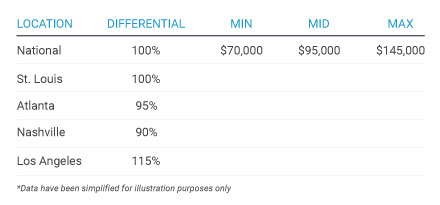Comparing Salaries in Different Cities Using Geographic Pay Differentials
Geographic salary differentials normalize salaries across various cities, regions, and locales based on the cost of labor. They enable one to evaluate a given salary, whether it be in San Francisco, New York City, or New Orleans. For example, an engineer living in St. Louis considers relocating to Atlanta, Los Angeles, or Nashville. How much would she have to earn in each of these cities to equate to her current salary of $95,000 in the Midwest, where the housing market and cost of living are considered affordable, based on her profession? How much would the employer in each of these cities consider as a reasonable salary offer to get her to move there and work for the organization?
How to Benchmark Geographic Wage Differentials in Competitive Markets
The employer is primarily concerned with market competitiveness. How much must the organization pay for competent labor in the current market? When and under what circumstances would it consider paying more than the market suggests? Does the company strategy include niche skills that are available through a very limited pool of candidates in a small industry or are there unlimited workers with readily available skills that translate across multiple industries? The candidate, on the other hand, will want to know about the cost of living in the cities being considered – how much money must she earn in order to afford housing, food, schools, transportation, and lifestyle. A move from the Midwest to San Francisco, where the housing market is extremely high, would require a considerable salary increase to maintain a standard of living realized in an area with a lower cost of living. The housing market in the south – New Orleans or Atlanta – might allow for a bigger house, even if the salary offered is lower. Typical salary and offer negotiations allow employers to consider offsetting the relocation expenses to ease the adjustment due to a higher cost of living. So, while an employer generally makes permanent decisions based on competition for labor, temporary cost-of-living allowances may be made for the employee to help with the relocation.
Geographic pay differentials are market-driven pay variations between geographic locations of the work performed. They are designed as a tool to create equitable compensation across labor markets, to the degree of verifiable differences in competitive salary levels across labor markets, most commonly using salary survey data. An organization’s compensation planning requires that it account for appropriate deviations in relevant labor markets, allowing for control of payroll/labor costs where it is not necessary to pay at higher levels, while ensuring adequate pay in areas where the market is much higher than the national average. Geographic salary differentials are often used to manage recruitment and retention difficulties, allowing organizations to attract and retain talent in premium markets, manage labor costs in non-premium markets, and facilitate perceptions of equitable pay.
Where the role or incumbent is located has a significant impact on determining base pay levels. Even though consideration of multiple geographic areas may add complexity in pay management, base pay is driven by location since pay reflects the cost of labor of the local market. Geographic differentials may be applied for specific cities, or cities with similar differentials may be grouped into geographic tiers. While market pricing jobs by city is considered a best practice for assigning locations to geographic pay differentials, it is not always practical or possible to use market data by city. As an alternative to salary differentials between cities, companies may create geographic pay differentials using a particular region or by grouping locations with similar market rates.
Organizations must consider alignment with the overall compensation philosophy and talent strategy. Local pay structures create a layer of complexity but, in general, ease administration and manager discretion. As employees move between locations, their salaries are adjusted to reflect ranges in the locations. To manage pay structures, companies need to determine how often they will review differential data to adjust ranges and pay inequities, annually at minimum. Additionally, they need to consider human resources information system (HRIS) implications for changing and maintaining multiple pay structures.
Example
The engineering company mentioned above has its headquarters located in St. Louis with offices/branches in the cities indicated in the table below. The candidate considers relocating to one of the branch locations. Using salary survey data, the following observations have been made:

From the data, base salary can be determined, based on differentials, and used to determine appropriate, fair, and equitable salaries for the candidate in each location, assuming 100% of the market value in terms of experience, skills, and knowledge:

If labor supply is short in some areas, jobs will reflect that. The candidate is free to negotiate salary and offer package (e.g., bonus potential, relocation, etc.). There are no strict guidelines, so the organization may choose to continue the current salary even though a lower one is indicated (as in Atlanta and Nashville) but increase it for large cities with high costs of living (as in Los Angeles). The compensation strategy should reflect where the company wants to pay in relation to what the market and competitors for talent are paying for jobs in each location.
